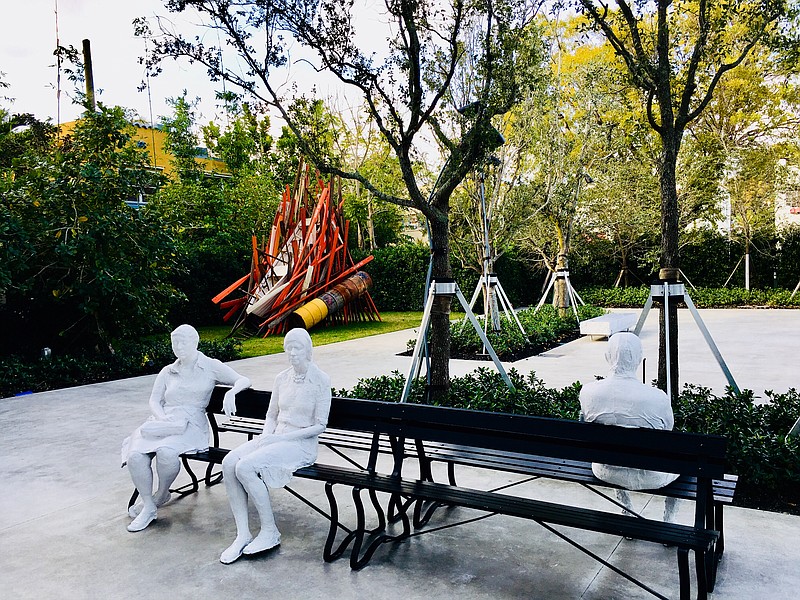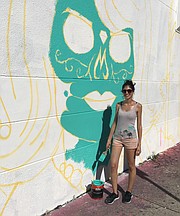If you go
(In order mentioned in this story)› The Bass Museum of Art, 2100 Collins Ave, Miami Beach, 305-673-7530, www.thebass.org› Pérez Art Museum Miami, 1105 Biscayne Blvd, Miami, 305-375-3000, www.pamm.org› Phillip and Patricia Frost Museum of Science, 1101 Biscayne Blvd, Miami, 305-434-9600, www.frostscience.org/› Institute of Contemporary Art, 61 NE 41st St, Miami, 305-901-5272, www.icamiami.org/tickets/› Wynwood Walls (central courtyard in the Wynwood Art District), 2520 NW 2nd Avenue, Miami, 305-531-4411, www.thewynwoodwalls.com
A four-story pile of rocks painted in fluorescent colors towered ahead of us as we drove north on Collins Avenue in Miami Beach, dodging weaving skateboards and erratically driven cars, bicycles and scooters, all seemingly determined to flout the rules of the road. In this part of Miami Beach, a dozen blocks north of sizzling South Beach, faded if gentrifying neighborhoods of midcentury apartment houses and stucco bungalows sat behind lush, if unkempt, tropical hedges. People of all ages, ethnicities and genders crowded the sidewalks.
We parked in a public lot with a view of the beach, the main draw for decades before the southern end of Miami Beach morphed into the trendy neighborhood of glitzy restaurants, nightclubs and boutiques that it is today. We were looking for the Bass Museum of Art, which reopened recently after a two-year, $12 million renovation and expansion, the latest entry on an exploding local art scene that includes three new art museums in Miami Beach and Miami itself.
As we guessed, the cairn marked the spot.
The museum, rebranded at its opening as The Bass, was a diminutive if perfect Art Deco specimen whose Florida limestone exterior glowed warmly in the November sun. The words Eternity Now, in giant blue letters, stretched across the façade - a "site-specific neon sculpture," we were later told.
Inside, I asked Ambar Herrera, who was welcoming visitors at the reception desk, if they'd been busy. "All day, every day," she said. "People have been waiting a long time for us to reopen." Her colleague at the desk, Gabrielle Peters, smiled when she answered a question about the cairn. "It's a sculpture called Miami Mountain, and it's 42 feet tall," she said, laughing when I pointed out Miami Beach sits less than 4 feet above sea level, making the sculpture quite a mountain.
The Florida press had eagerly anticipated the reopening. But when the doors opened, the coverage focused on one thing: the eggs.
You can't miss the eggs. Alabaster eggs, the size of the jumbos in your refrigerator and painted every conceivable color, are stuck to the walls throughout the first-floor permanent collection and exhibition galleries (which featured a contemporary multimedia show by Cameroonian artist Pascale Marthine Tayou). They surround the Rubens and the Botticellis and the Renaissance tapestries that hang on the walls.
Not everyone gets it. I didn't, at first.
One woman, in a green Santa Fe T-shirt and shorts with a bottle of water strapped to her waist, started browbeating one of the guards. "I'm an artist, and none of this makes any sense to me," she said. "I don't like art galleries that tell me I'm stupid because I don't get the joke."
"Well," the guard answered, after listening to her patiently, "Isn't art what you make of it?"
I asked a woman in a blue Bass blazer about the eggs. "They're about inclusion," she said. "As an art museum, we want to emphasize that life is always evolving, that we all started out the same way, but now we're different and that needs to be embraced. We want to emphasize a message of tolerance."
Upstairs, three installations by Swiss-born New York artist Ugo Rondinone were free of eggs. One featured an array of lifelike harlequins sitting in different postures on the floor. A guard at the entrance, Tali Rodriguez, told me a woman had just peered in but said she was "afraid of clowns" and had stormed off. I didn't ask if she'd been wearing a Santa Fe T-shirt.
Another New Art Museum
The reopening of The Bass was preceded by the 2013 opening of the Pérez Art Museum Miami on the mainland at the foot of the MacArthur Causeway to Miami Beach, across Biscayne Bay. The museum, whose design incorporates walls of tropical greenery and falling water, sits in Museum Park with the even newer Phillip and Patricia Frost Museum of Science, which includes an aquarium.
The Pérez focuses on contemporary art, primarily by living artists from the Americas. But I was most drawn to an exhibit of scaled-down replicas of ships and boats by Hew Locke, a British artist of Guyanese descent. The colorful vessels were hanging from the ceiling of a cavernous hall and resembled an armada, fitting for this maritime location.
Outside, I strolled the terrace, savoring the view of the crystalline bay. Cruise ships were casting off for their weekly Saturday evening departures through Government Cut. Hammock chairs hung from an overhang, delighting visitors who swung to and fro.
Bramans Fund New Art Institute
The Institute of Contemporary Art, which opened in mid-December, is farther afield in Miami's exclusive Design District, which includes high-end fashion boutiques, upscale restaurants and enticing pocket parks filled with outdoor art installations. The museum includes a sculpture garden and research center. It offers the city's most groundbreaking contemporary art collection with works from the United States and abroad and a smattering of work by modern masters, including Roy Lichtenstein and Pablo Picasso.
The museum, with free admission, was funded almost entirely by billionaire car magnate and Miami resident Norman Braman, former owner of the Philadelphia Eagles, and his wife Irma, who have lent numerous works from their own collection to the museum. The Bramans and other backers, whose help the Bramans enlisted, also have funded the first 10 years of the museum's operating expenses.
Wynwood Pushes the Envelope
A couple of miles away, the Wynwood Art District sits smack dab in the middle of a vast light-industrial area pocked with desolate patches of low-rent housing. Artists in Wynwood have reclaimed the walls of old warehouses as canvases for resplendent murals - hundreds of them. They sit cheek-by-jowl with incongruously tony art galleries, shops and restaurants, newcomers to the neighborhood. Regarded as the most authentic manifestation of the local art scene, Wynwood attracts crowds to its festive art walks, held every second Saturday. Many of the murals feature fanciful, surrealistic characters and scenes, but others are strikingly realistic. Some offer political and social commentary. Some are risqué (and some are X-rated).
The area, once a center of textile manufacturing, has had a gritty past, and gangs still dangle shoes from electrical wires in remote parts to mark their turf. But we encountered only selfie- taking tourists - lots of them.
Miami's arrival on the international art scene is best demonstrated by its participation each December in Art Basel, the enormous international art fair that also features iterations in Basel, Switzerland, and Hong Kong. It attracts a glittering, continent-hopping crowd of upwards of 70,000 people, straining Miami area hotels and restaurants to capacity.

